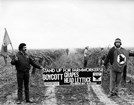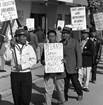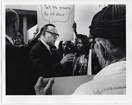In the spring of 1966, a small group of California farmworkers and their supporters captured the attention of the nation. On March 17, nearly a hundred striking farmworkers, most of them Mexican American and Filipino, set out on foot from Delano, bound for the state capital in Sacramento, some 280 miles to the north. They marched to shine a light on the conditions in the fields and to demand for farmworkers the fundamental rights and freedoms to which other American workers were entitled.
-
César E. Chávez National Monument
Article 1: Marching for Justice in the Fields

The farm workers who marched from Delano to Sacramento represented the large, seasonal labor force, composed overwhelmingly of people of color, whose labor made California’s thriving agricultural industry possible. Although their labor produced fortunes from the soil, they were subjected to poor wages and working conditions. This article is an introduction to the issues that motivated the Delano Grape Strike and the 1966 march. Read more
-
César E. Chávez National Monument
Article 2: Thirty Years of Farmworker Struggle

Labor organizing has a long history in agriculture. Between 1930 and 1960, diverse groups of farmworkers in California struggled to form unions and to take collective action for better wages and working conditions. This article highlights the political and legal structures that made organizing in the fields especially difficult. Read more
-
César E. Chávez National Monument
Article 3: The Terrain of Farmworker Life

Large-scale commercial agriculture or agribusiness has shaped the landscape of California's Central Valley for over a century. This article explores the social and economic world created by agribusiness in and around the small city of Delano, with an emphasis on the lives of the predominately Filipino, Mexican, and Mexican American farm workers and their families. Read more
-
César E. Chávez National Monument
Article 4: A New Era of Farmworker Organizing

This article explores changes in farm work and farmworker organizing that took place in the 1960s. The end of the Bracero Program, a strike wave, and the emergence of the Black Freedom Movement, all played a role in expanding the opportunities for farmworker organizing. So too did the emergence of a new organization, the National Farm Workers Association. Read more
-
César E. Chávez National Monument
Article 5: Workers United: The Delano Grape Strike and Boycott

The decision to strike was full of risk for farmworkers and their families. In addition to lost wages, many also faced eviction from housing owned by growers. Nonetheless, in the fall of 1965, thousands of workers in the Delano grape fields voted in favor of striking This article explores the early months of the strike as well as the successful consumer boycott campaign initiated by the National Farm Workers Association. Read more
-
César E. Chávez National Monument
Article 6: Mobilizing Support for La Causa

After six months of picketing and protest, the Delano Grape strikers remained out of work with no grower agreeing to a contract. The situation demanded bold action. This article explores the decision to organize a historic march to the state capital in Sacramento and examines the planning, preparation, and execution of the historic pilgrimage. Read more
-
César E. Chávez National Monument
Article 7: A Continuing Struggle

As the 1966 march by farmworkers from Delano to Sacramento neared its conclusion, the workers won an important victory. Schenley Industries agreed to negotiate a contract. However, the struggle to bring other growers to the bargaining table continued. Read more
